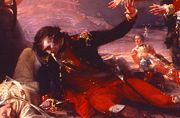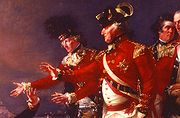
The Sortie Made by the Garrison of Gibraltar, 1789
Encyclopedia
The Sortie Made by the Garrison of Gibraltar, 1789 (also called The Sortie made by the Garrison of Gibraltar in the Morning of the 27 of November 1781) is the title of a 1789 oil-on-canvas painting
by American
artist John Trumbull
. The painting depicts the siege made by the Spanish forces
against the British at Gibraltar
in 1781. Trumbull focuses on the death of Spanish officer Don Jose de Barboza
who had been abandoned by his own troops but who nevertheless attacked the British column and thereby earned the respect of the British.
on November 27, 1781. The Great Siege of Gibraltar
was an unsuccessful attempt by Spain
and France
to capture Gibraltar from the British
during the War of American Independence
.
 The painting depicts the events of the night of November 26, 1781 when British troops made a sudden attack (sortie
The painting depicts the events of the night of November 26, 1781 when British troops made a sudden attack (sortie
), against the enemy batteries. The death of the Spanish officer Don Jose de Barboza is the focal point of the painting. He fell mortally wounded and died near his post refusing assistance after having been abandoned by his troops. He is portrayed as rejecting the aid of General George Elliott
, commander of the British troops.
 In 1782, the Siege was lifted and Trumbull's friend Antonio de Poggi, an artist and dealer based in London
In 1782, the Siege was lifted and Trumbull's friend Antonio de Poggi, an artist and dealer based in London
who had been in the besieged garrison, told him of an earlier incident, which had occurred in November 1781.
This had all the ingredients he sought:
Trumbull labored on the composition, over many sketches and three large completed canvases. As the project progressed, Trumbull's ambitions for it to be his big breakthrough to major patronage grew too. He refused large offers for the picture, preferring to exhibit it privately for admission fees.
Horace Walpole, 4th Earl of Orford
had called the painting:
The painting is depicted on the back of the 2010 Gibraltar 10-pound note.
Oil painting
Oil painting is the process of painting with pigments that are bound with a medium of drying oil—especially in early modern Europe, linseed oil. Often an oil such as linseed was boiled with a resin such as pine resin or even frankincense; these were called 'varnishes' and were prized for their body...
by American
United States
The United States of America is a federal constitutional republic comprising fifty states and a federal district...
artist John Trumbull
John Trumbull
John Trumbull was an American artist during the period of the American Revolutionary War and was notable for his historical paintings...
. The painting depicts the siege made by the Spanish forces
Great Siege of Gibraltar
The Great Siege of Gibraltar was an unsuccessful attempt by Spain and France to capture Gibraltar from the British during the American War of Independence. This was the largest action fought during the war in terms of numbers, particularly the Grand Assault of 18 September 1782...
against the British at Gibraltar
Gibraltar
Gibraltar is a British overseas territory located on the southern end of the Iberian Peninsula at the entrance of the Mediterranean. A peninsula with an area of , it has a northern border with Andalusia, Spain. The Rock of Gibraltar is the major landmark of the region...
in 1781. Trumbull focuses on the death of Spanish officer Don Jose de Barboza
Don Jose de Barboza
Don Jose de Barboza was an officer of the Kingdom of Spain.- Biography :Jose de Barboza was one of the young officers sent to the Great Siege of Gibraltar. Though abandoned by his men, Barboza fought on and attacked the British column head-on. The don was mortally wounded by a gunshot wound to the...
who had been abandoned by his own troops but who nevertheless attacked the British column and thereby earned the respect of the British.
Background
The painting is based on a real attack that took place in GibraltarGibraltar
Gibraltar is a British overseas territory located on the southern end of the Iberian Peninsula at the entrance of the Mediterranean. A peninsula with an area of , it has a northern border with Andalusia, Spain. The Rock of Gibraltar is the major landmark of the region...
on November 27, 1781. The Great Siege of Gibraltar
Great Siege of Gibraltar
The Great Siege of Gibraltar was an unsuccessful attempt by Spain and France to capture Gibraltar from the British during the American War of Independence. This was the largest action fought during the war in terms of numbers, particularly the Grand Assault of 18 September 1782...
was an unsuccessful attempt by Spain
Spanish Empire
The Spanish Empire comprised territories and colonies administered directly by Spain in Europe, in America, Africa, Asia and Oceania. It originated during the Age of Exploration and was therefore one of the first global empires. At the time of Habsburgs, Spain reached the peak of its world power....
and France
Early Modern France
Kingdom of France is the early modern period of French history from the end of the 15th century to the end of the 18th century...
to capture Gibraltar from the British
British Empire
The British Empire comprised the dominions, colonies, protectorates, mandates and other territories ruled or administered by the United Kingdom. It originated with the overseas colonies and trading posts established by England in the late 16th and early 17th centuries. At its height, it was the...
during the War of American Independence
American Revolutionary War
The American Revolutionary War , the American War of Independence, or simply the Revolutionary War, began as a war between the Kingdom of Great Britain and thirteen British colonies in North America, and ended in a global war between several European great powers.The war was the result of the...
.
Painting

Sortie
Sortie is a term for deployment or dispatch of one military unit, be it an aircraft, ship, or troops from a strongpoint. The sortie, whether by one or more aircraft or vessels, usually has a specific mission....
), against the enemy batteries. The death of the Spanish officer Don Jose de Barboza is the focal point of the painting. He fell mortally wounded and died near his post refusing assistance after having been abandoned by his troops. He is portrayed as rejecting the aid of General George Elliott
George Augustus Eliott, 1st Baron Heathfield
George Augustus Eliott, 1st Baron Heathfield, KB was a British Army officer who took served in three major wars during the eighteenth century. He rose to distinction during the Seven Years War when he fought in Germany and participated in the British attacks on Belle Île and Cuba...
, commander of the British troops.

London
London is the capital city of :England and the :United Kingdom, the largest metropolitan area in the United Kingdom, and the largest urban zone in the European Union by most measures. Located on the River Thames, London has been a major settlement for two millennia, its history going back to its...
who had been in the besieged garrison, told him of an earlier incident, which had occurred in November 1781.
This had all the ingredients he sought:
Trumbull labored on the composition, over many sketches and three large completed canvases. As the project progressed, Trumbull's ambitions for it to be his big breakthrough to major patronage grew too. He refused large offers for the picture, preferring to exhibit it privately for admission fees.
Horace Walpole, 4th Earl of Orford
Horace Walpole, 4th Earl of Orford
Horatio Walpole, 4th Earl of Orford was an English art historian, man of letters, antiquarian and Whig politician. He is now largely remembered for Strawberry Hill, the home he built in Twickenham, south-west London where he revived the Gothic style some decades before his Victorian successors,...
had called the painting:
The painting is depicted on the back of the 2010 Gibraltar 10-pound note.

